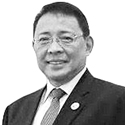
Signs And Wonders
By Diwa C. Guinigundo

(1st of two parts)
Until I retired in 2019, I was one of the deputies of central banks and ministries of finance in the ASEAN+3 region who, over the last 20 years, tried putting together the various components of the regional financing mechanism that we now call the $240-billion Chiang Mai Initiative Multilateralization (CMIM).
Against the backdrop of the Asian Financial Crisis in 1997-98, our principals issued a directive in Chiang Mai, Thailand in 1999 to strengthen regional cooperation and build a regional safety net. It was imperative to complement and strengthen the global financial facilities provided by the International Monetary Fund (IMF). It was a long journey of spirited debates and backroom negotiations on the amount of regional financing, distribution of shares and voting powers, and de-linking a portion from an IMF adjustment program, if necessary, to make it quick disbursing and more flexible. And more debates on the organizational structure on how financial stability would be delivered.
That is how the ASEAN+3 Macroeconomic Research Office (AMRO) was formed, with its own staff of economists and analysts to do independent, strategic regional surveillance. Surveillance provides the basis for assessing the risks and challenges that could trigger a potential balance of payments problem and warrant the activation of the CMIM. CMIM began with bilateral swap arrangements with a modest initial funding of $80 billion, until it was multilateralized and increased by 50% to $120 billion, and later doubled to $240 billion. The bigger +3 countries — China and Hong Kong, Japan, and South Korea —contributed the largest chunk, followed by the ASEAN 5 (Indonesia, Malaysia, the Philippines, Singapore, and Thailand), and in varying amounts according to their financial capability, the rest of the ASEAN 10 (Brunei, Cambodia, Indonesia, Laos, Malaysia, Myanmar, the Philippines, Singapore, Thailand, and Vietnam).
The idea was based on the principle of self-reliance, that when national safety nets, such as the member countries’ foreign exchange reserves, are not sufficient and bilateral swap arrangements fall short of the requirements, we could use a regional financing mechanism before the ASEAN+3 constituent countries run to the Fund for help. This is crucial because any amount from Washington is covered by conditionalities — lots of conditionalities — including the need for policy and structural reforms. Since the ASEAN+3 economies hold trillions of dollars together, it makes sense to create a regional financing arrangement that could be tapped anytime based on protocols.
AN ADVISORY PANEL AND REPORTS
To ensure an independent AMRO, we formed the Advisory Panel to be composed of senior government and central bank officials, and respected academicians and researchers. Country reports, the AMRO Regional Economic Outlook (AREO), and, starting this year, the ASEAN+3 Financial Stability Report (AFSR) are discussed with the Advisory Panel during its quarterly meetings. The panel is expected to provide an open and frank exchange of perspectives on these staff outputs, to serve as a second pair of eyes and, in the process, to achieve a more independent assessment of the region.
For two years, 2023 to 2025, the Bangko Sentral ng Pilipinas nominated me for, and the 10 ASEAN member countries voted me into, the six-member Advisory Panel. During the initial meeting of the panel early this year, I was elected to chair the meetings for a period of one year until the chairmanship is passed on to the next person.
It was in that capacity that I attended the Annual Meeting of Central Bank and Finance Deputies in Kanazawa, Japan during the first week of December, and conveyed to the deputies the general observations of the Panel. We expressed the view that with the AREO and now, the twin publication AFSR, in the mainstream, we are more prepared to translate the idea of closer regional financial cooperation into something concrete and functional. In case the CMIM is activated, this will happen with full information and assessment of the real situation on the ground. AMRO staff are annually sent on missions to member countries to collect local data and perspectives to empower them in writing country reports and advising member economies on appropriate policy options. We can then assure our taxpayers that public money is used judiciously to help each other, that due diligence is rigorously done.
GENERAL OBSERVATIONS
What were the general observations of the Panel?
We all agreed that we have weathered the global pandemic and geopolitical risks relatively well, without the need for exceptional external financing support.
And it looks like we can put behind us the headwinds that hit during the pandemic, when almost all the world was locked down and business activities were at a standstill. Economic scarring was deepest in the labor market. But based on the latest data, there have been brighter spots, some silver lining like recovery efforts taking root in many economies. Thus, instead of the headwinds, we now face crosswinds that could at times produce some disturbances on the sides.
But the balance of risks remains on an upward drift.
If global value chains foul up, it is indeed possible to see a resurgence in global commodity prices, and if the US Fed remains hawkish, regional currencies could weaken. Recent disinflation may not be enough to put behind us higher interest rates without linking this to financial stability. While AMRO’s assessment of the economic recovery in China is more optimistic than the Fund’s based on its fixed asset investment, industrial profits, and real consumer spending, it was also correct to list China’s slower recovery as a short-term risk with low probability. The US-China geopolitical tension should truly be a long-term risk with low likelihood because it is against everybody’s long-term interest. Making noise is far superior to fighting a war.
TROUBLING PUBLIC DEBT
At the same time, the Advisory Panel observed that due to pandemic exigencies, public debt has risen to some disturbing proportions, together with both corporate and, most especially, household debt. The region’s total debt to GDP ratio has steadily risen, peaking at 325% during the pandemic before coming down to 299%, which is still a source of concern.
AMRO stress tested and found that fiscal sustainability and financial stability may not exactly be in clear and present danger. While the issue of indebtedness across the household, corporate, and sovereign debt was amplified in the AFSR, it would also be imperative to impress upon the authorities that if allowed to accumulate more, and at a more rapid pace, the debt issue could graduate to the front and center of public policy concern.
That is why, while the debt issue continues to evolve, it would be worthwhile to focus on those debts involving the non-bank financial institutions which may be outside the regulatory and supervisory ambits of some central banks and banking regulators. Very little is known about them, including the extent of their lending to banks and other corporates — that which involves non-trivial maturity and currency transformation. To the extent that they are related to banks and, therefore, the whole entity qualifies as a financial conglomerate, data gaps may exist and should be addressed to allow for stronger risk management.
Thus, while we should not worry as yet, neither should we be complacent.
For instance, with the current uncertain and volatile external environment, many countries have begun the cycle of de-risking and, in some cases, decoupling. Countries tend to rely more on domestic supplies and less on imports. Moreover, global demand also appears to shift from goods to services and this is quite noticeable in the US and China. What this holds for the region should be examined and addressed.
DEEPER ASSESSMENT
True, economic recovery seems to be gaining more ground in the major economies. The question reduces to how much would be the net impact be on the ASEAN+3. AMRO will need to take a deep dive into these two developments so we can have a deeper assessment of the regional outlook for designing adjustment policies, should they be necessary.
In the financial sector, the AFSR is truly a welcome knowledge resource. It made the point that higher policy rates, which impinge on the bank clients’ ability to service their debt, could raise their non-performing loans. However, it cuts both ways in that the banks’ net interest margins could also increase. AMRO should be looking into this point at whether there are lags involved from interest rate adjustments to both lending and deposit.
Finally, while we have had access to monetary and fiscal tools as well as prudential tools in the last few years, it seems we now realize the limitations of traditional tools. The point is that to begin building up monetary and fiscal space again, we may need to consider a broader range of macroprudential tools. The point is to enhance the attractiveness of the region through purposeful structural and policy reforms — on governance, on climate change, on green finance, and add to that, stronger fiscal consolidation and debt management — and that would truly prepare us for the cycle of more sustainable regional economic growth.
(To be continued.)
Diwa C. Guinigundo is the former deputy governor for the Monetary and Economics Sector, the Bangko Sentral ng Pilipinas (BSP). He served the BSP for 41 years. In 2001-2003, he was alternate executive director at the International Monetary Fund in Washington, DC. He is the senior pastor of the Fullness of Christ International Ministries in Mandaluyong.